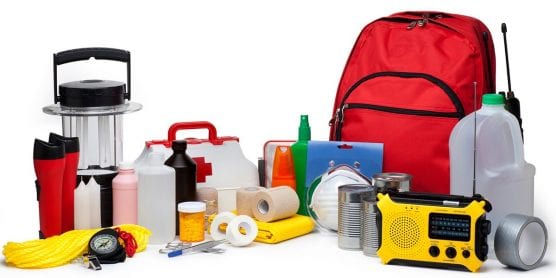LOS ANGELES — Fifty years ago the American Red Cross Los Angeles Region sheltered 17,000 people and assisted 11,000 families following the catastrophic 1971 San Fernando earthquake (Sylmar earthquake). On this somber anniversary, the Red Cross urges Angelenos to take the necessary steps to prepare their households for the next Big One.
The 6.6 jolt on Feb. 9, 1971 was the first major earthquake to hit Los Angeles in 80 years and left thousands of residents without water, power or gas for weeks. The earthquake caught many Southland residents unprepared for a disaster of such magnitude and saw people respond with outdated notions on how to remain safe immediately following an earthquake.
“I was only seven years old when the Sylmar quake hit, but I remember every frightening detail of that morning,” said Mimi Teller Rosicky, Red Cross LA disaster volunteer. “In retrospect, my family did everything wrong – between standing in doorways then running outside barefoot, we were lucky our lack of knowledge didn’t harm us.”
Through its PrepareSoCal campaign, the Red Cross and partners strive to engage community leaders in the most vulnerable Southern California neighborhoods to bring preparedness education to every household.
The goal is for all Los Angeles residents to be equipped with enough food, water and emergency supplies to last for two weeks until outside help can arrive. The Red Cross recommends five basic steps:
– Get a kit – Build an easy-to-carry emergency preparedness kit that you can use at home or take with you if you must evacuate. Include items such as water, non-perishable food, a flashlight and extra batteries, a battery-powered radio, first aid kit and medications. Don’t forget disinfectant and hygiene items like soap and hand sanitizer to protect against COVID-19.
– Make a plan – Talk with members of your household about what to do during emergencies. Plan what to do in case everyone is separated and choose two places to meet—one right outside your home in case of a sudden emergency such as a fire, and another outside your neighborhood, in case you cannot return home or are asked to evacuate.
Be informed – Know what to do before, during and after an earthquake. Practice DROP, COVER and HOLD ON with all members of your household.
– Learn CPR – In an emergency, you will be the first person on the scene. Make sure at least one member of your household is fully trained to administer CPR and First Aid.
– Download the Red Cross Emergency App – This FREE all-inclusive app lets you monitor more than 35 different severe weather and emergency alerts, provides expert advice on how to prepare and respond to disasters and includes a map to help you locate open Red Cross shelters. Available for download in your app store of choice or by texting: “GETEMERGENCY” to 90999.
Additionally, you can take the ‘I’m Ready’ quiz to see if you’re ready for disasters by visiting preparesocal.org. This self-evaluation will help you determine if you’ve taken all the five steps recommended by the Red Cross in order to be ready for earthquakes, home fires and wildfires.
Earthquake Safety
During an earthquake, do not try to move around. Drop, Cover and Hold On. Try to protect your head and torso. If you are sitting at a desk or table, get under it. Otherwise drop wherever you are.
– If you are in bed, stay there, curl up and hold on. Protect your head with a pillow.
– If you are inside, stay indoors until the shaking stops and you are sure it is safe to exit. When it is, use stairs rather than the elevator in case there are aftershocks, power outages or other damage.
– If you are outside, find a clear spot (away from buildings, power lines, trees, streetlights) and drop to the ground. Stay there until the shaking stops.
– If you are in a vehicle, pull over to a clear location and stop. Avoid bridges, overpasses and power lines if possible. Stay inside with your seatbelt fastened until the shaking stops. Then, drive carefully, avoiding bridges and ramps that may have been damaged.
– If you are in a mountainous area or near unstable slopes or cliffs, be alert for falling rocks and other debris. Landslides are often triggered by earthquakes.
About the American Red Cross:
The American Red Cross shelters, feeds and provides emotional support to victims of disasters; supplies about 40 percent of the nation’s blood; teaches skills that save lives; provides international humanitarian aid; and supports military members and their families. The Red Cross is a not-for-profit organization that depends on volunteers and the generosity of the American public to perform its mission. For more information visit redcross.org/la or cruzrojaamericana.org, or visit us on Twitter at @RedCrossLA or @CruzRojaLA.
Like this:
Like Loading...
Related





 Tweet This
Tweet This Facebook
Facebook Digg This
Digg This Bookmark
Bookmark Stumble
Stumble RSS
RSS


























REAL NAMES ONLY: All posters must use their real individual or business name. This applies equally to Twitter account holders who use a nickname.
0 Comments
You can be the first one to leave a comment.